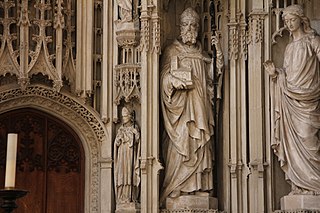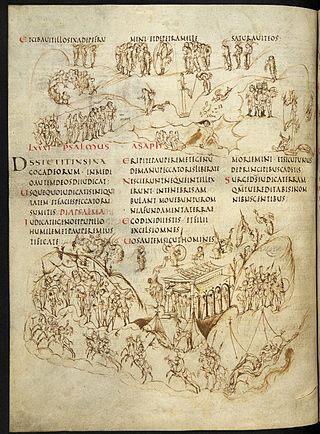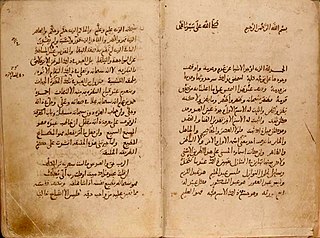Related Research Articles

The Codex Vaticanus, designated by siglum B or 03, δ 1, is a Christian manuscript of a Greek Bible, containing the majority of the Greek Old Testament and the majority of the Greek New Testament. It is one of the four great uncial codices. Along with Codex Alexandrinus and Codex Sinaiticus, it is one of the earliest and most complete manuscripts of the Bible. Using the study of comparative writing styles (palaeography), it has been dated to the 4th century.

Matthew Paris, also known as Matthew of Paris, was an English Benedictine monk, chronicler, artist in illuminated manuscripts, and cartographer who was based at St Albans Abbey in Hertfordshire, he authored a number of historical works, many of which he scribed and illuminated himself, typically in drawings partly coloured with watercolour washes, sometimes called "tinted drawings". Some were written in Latin, others in Anglo-Norman or French verse. He is sometimes confused with the nonexistent Matthew of Westminster.
The Hengwrt Chaucer manuscript is an early-15th-century manuscript of the Canterbury Tales, held in the National Library of Wales, in Aberystwyth. It is an important source for Chaucer's text, and was possibly written by someone with access to an original authorial holograph, now lost.

St Erkenwald is a fourteenth-century alliterative poem in Middle English, perhaps composed in the late 1380s or early 1390s. It has sometimes been attributed, owing to the Cheshire/Shropshire/Staffordshire Dialect in which it is written, to the Pearl poet who probably wrote the poems Pearl, Patience, Cleanness, and Sir Gawain and the Green Knight.

The Auchinleck Manuscript, NLS Adv. MS 19.2.1, is an illuminated manuscript copied on parchment in the 14th century in London. The manuscript provides a glimpse of a time of political tension and social change in England. The English were continuing to reclaim their language and national identity, and to distance themselves from the Norman conquerors who had taken over the country after the Battle of Hastings 300 years before. It is currently in the collection of the National Library of Scotland.
The Alliterative Morte Arthure is a 4346-line Middle English alliterative poem, retelling the latter part of the legend of King Arthur. Dating from about 1400, it is preserved in a single copy in the 15th-century Lincoln Thornton Manuscript, now in Lincoln Cathedral Library.

The Utrecht Psalter is a ninth-century illuminated psalter which is a key masterpiece of Carolingian art; it is probably the most valuable manuscript in the Netherlands. It is famous for its 166 lively pen illustrations, with one accompanying each psalm and the other texts in the manuscript. The precise purpose of these illustrations, and the extent of their dependence on earlier models, have been matters of art-historical controversy. The psalter spent the period between about 1000 to 1640 in England, where it had a profound influence on Anglo-Saxon art, giving rise to what is known as the "Utrecht style". It was copied at least three times in the Middle Ages. A complete facsimile edition of the psalter was made in 1875, and another in 1984 (Graz).

The Stowe Psalter is a psalter from the "2nd or 3rd quarter of the 11th century", at the end of Anglo-Saxon art. The text includes the Gallican version of the Psalms, followed by the Canticles with an interlinear Old English gloss.
The Pilgrimage of the Soul or The Pylgremage of the Sowle was a late medieval work in English, combining prose and lyric verse, translated from Guillaume de Deguileville's Old French Le Pèlerinage de l'Âme. It circulated in manuscript in fifteenth-century England, and was among the works printed by William Caxton. One manuscript forms part of the Egerton Collection in the British Library.
John Audelay was an English priest and poet from Haughmond Abbey, in Shropshire; one of the few English poets of the period whose name is known to us. Some of the first Christmas carols recorded in English appear among his works.
Robert Thornton was a Yorkshire landowner, a member of the landed gentry. His efforts as an amateur scribe and manuscript compiler resulted in the preservation of many valuable works of Middle English literature, and have given him an important place in its history.

The Anglo-Saxon Chronicle is a collection of annals in Old English, chronicling the history of the Anglo-Saxons.
The Lincoln Thornton Manuscript is a medieval manuscript compiled and copied by the fifteenth-century English scribe and landowner Robert Thornton, MS 91 in the library of Lincoln Cathedral. The manuscript is notable for containing single versions of important poems such as the Alliterative Morte Arthure and Sir Perceval of Galles, and gives evidence of the variegated literary culture of fifteenth-century England. The manuscript contains three main sections: the first one contains mainly narrative poems ; the second contains mainly religious poems and includes texts by Richard Rolle, giving evidence of works by that author which are now lost; and the third section contains a medical treatise, the Liber de diversis medicinis.

The Harley Lyrics is the usual name for a collection of lyrics in Middle English, Anglo Norman, and Latin found in Harley MS 2253, a manuscript dated ca. 1340 in the British Library's Harleian Collection. The lyrics contain "both religious and secular material, in prose and verse and in a wide variety of genres." The manuscript is written in three recognisable hands: scribe A, scribe B or the Ludlow scribe, and scribe C.

An autograph or holograph is a manuscript or document written in its author's or composer's hand. The meaning of autograph as a document penned entirely by the author of its content, as opposed to a typeset document or one written by a copyist or scribe other than the author, overlaps with that of holograph.
Thorlac Francis Samuel Turville-Petre is an English philologist who is Professor Emeritus and former head of the School of English at the University of Nottingham. He specializes in the study of Middle English literature.

"Alysoun" or "Alison", also known as "Bytuene Mersh ant Averil", is a late-13th or early-14th century poem in Middle English dealing with the themes of love and springtime through images familiar from other medieval poems. It forms part of the collection known as the Harley Lyrics, and exemplifies its best qualities. There may once have been music for this poem, but if so it no longer survives. "Alysoun" was included in The Oxford Book of English Verse, The Norton Anthology of English Literature, and The Longman Anthology of British Literature. It has been called one of the best lyrics in the language.
"Lenten ys come with love to toune", also known as "Spring", is an anonymous late-13th or early-14th century Middle English lyric poem which describes the burgeoning of nature as spring arrives, and contrasts it with the sexual frustration of the poet. It forms part of the collection known as the Harley Lyrics. Possibly the most famous of the Middle English lyrics, it has been called one of the best lyrics in the language, and "a lover's description of spring, richer and more fragrant in detail than any other of its period." No original music for this poem survives, but it has been set to music by Benjamin Britten, Alan Rawsthorne and others. It was included in The Oxford Book of English Verse.
Oxford, Bodleian Library, MS Fairfax 16, also known as the Fairfax Manuscript, is a fifteenth-century Middle English poetic anthology which contains one of the finest collections of Chaucerian verse of this period. Owned and commissioned by John Stanley of Hooton, Cheshire, Fairfax 16 was produced in Oxford or London in the mid-fifteenth century. Thomas Fairfax bequeathed it to the Bodleian Library in 1671.

The Pearl Manuscript, also known as the Gawain manuscript, is an illuminated manuscript produced somewhere in northern England in the late 14th century or the beginning of the 15th century. It is one of the best-known Middle English manuscripts, the only one containing alliterative verse solely, and the oldest surviving English manuscript to have full-page illustrations. It contains the only surviving copies of four of the masterpieces of medieval English literature: Sir Gawain and the Green Knight, Pearl, Cleanness, and Patience. It has been described as "one of the greatest manuscript treasures for medieval literature", and "the most famous of all romance manuscripts".
References
- Notes
- Bibliography
- Fein, Susanna Greer (1989). "'Haue Mercy of Me' (Psalm 51): An Unedited Alliterative Poem from the London Thornton Manuscript". Modern Philology . 86 (3): 223–41. doi:10.1086/391701. S2CID 161094763.
- Thompson, John J. (1979). "Lincoln Cathedral Library MS. 91: Life and Milieu of the Scribe". Studies in Bibliography . 32: 158–79.
- Keiser, George R.. (1983). "More Light on the Life and Milieu of Robert Thornton". Studies in Bibliography . 36: 111–19.
- Thompson, John J. (1987). Robert Thornton and the London Thornton manuscript: British Library MS Additional 31042. D.S. Brewer. ISBN 978-0-85991-190-0.